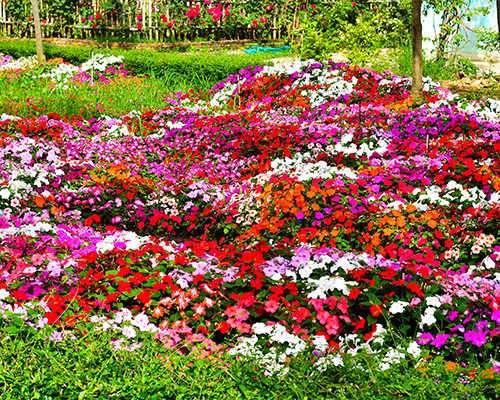Growing Annuals
“Friends, like flowers, make life more beautiful.”
Michele Farabee
Color in your Garden
Annuals provide more color and interest for longer periods of time than any other garden plants. Also known as bedding plants, annuals can be used to put color anywhere in your garden or landscape, in containers, window boxes, on decks and patios or to beautify steps, entryways and just about any place color is desired.


Soil Preparation
Good soil preparation is essential for all plants.
- Deeply turn over and loosen the soil to a depth of 6 to 10 inches. Improve sandy and clay soils by mixing in at least 2 inches of compost or peat moss to improve drainage and aeration. Raised beds and containers can be used to ensure adequate drainage in poorly drained or compacted areas.
- Add a complete fertilizer (such as 5-10-5 at the rate of 1 pound per 100 square feet of bed area) or a complete time-release fertilizer (such as Osmocote) according label directions.
- A pH of around 6.5 is good for most annuals; bring ½ cup of dry soil in and we can test it for you for free to see if lime is required.
- Incorporate lime (if needed) and fertilizer into the top 4 to 6 inches of soil after mixing in the soil amendments. Rake the soil surface smooth.
- Avoid working soil while it is wet (too early in spring) since this can cause compaction and poor air, water and root penetration.
Lifecycle and Cold Tolerance
Within one season, true annuals sprout from seed, flower, set seed and die, so most must be replaced every year in the garden. Annuals are commonly grouped as tender (warm season), hardy or half-hardy (cool-weather tolerant).
Tender annuals, such as vincas, zinnias and impatiens, cannot tolerate freezing temperatures. They should be planted in the spring after all danger of frost is past (early May).
Hardy annuals, such as pansies, ornamental kale and cabbage, are grown for color in cool and cold seasons. They are usually planted in the fall. Most decline or die with the onset of summer heat.
Half-hardy annuals, such as alyssum and dianthus, can tolerate light frost and are usually planted in early spring for spring and early summer color. They usually decline in summer heat but may bloom again in the fall.
Location: Most annuals need full sun for at least 4-6 hours a day to flower well, but there are also many to choose from that are shade tolerant. Avoid planting in areas where water stands for more than a few hours after a heavy rain.
When and How to Plant
To remove fiber and plastic pots planting; remove the upper edges of peat pots so that the pot will not act as a wick, pulling water away from the roots. Pinch off any buds and flowers when planting to promote better branching and a stronger plant.
Once transplanting is complete, water the plants thoroughly. Pay especially close attention to watering in the first few weeks while plants develop their root systems. Adequate moisture is essential for the growth of flowering annuals.
Tender Annuals
Wait to plant tender annuals outdoors until the danger of frost has passed, usually around mid-May. Many annuals, even if not injured by low temperatures, will not grow well until the soil warms. Harden-off young plants by placing them outdoors a few days before you actually plant them in the ground to get them used to the outdoor conditions.
Hardy Annuals
Plant hardy annuals at least 6 weeks before the expected first fall frost date to allow time for sufficient root development. They should be planted with the top of the roots just under the surface of the soil.
What You’ll Need
- Fertilizer
- Lime
- Gloves
- Spading Fork
- Mulch
- Soaker Hose
- Trowel
Download or print a PDF of Growing Annnuals
TOOL
